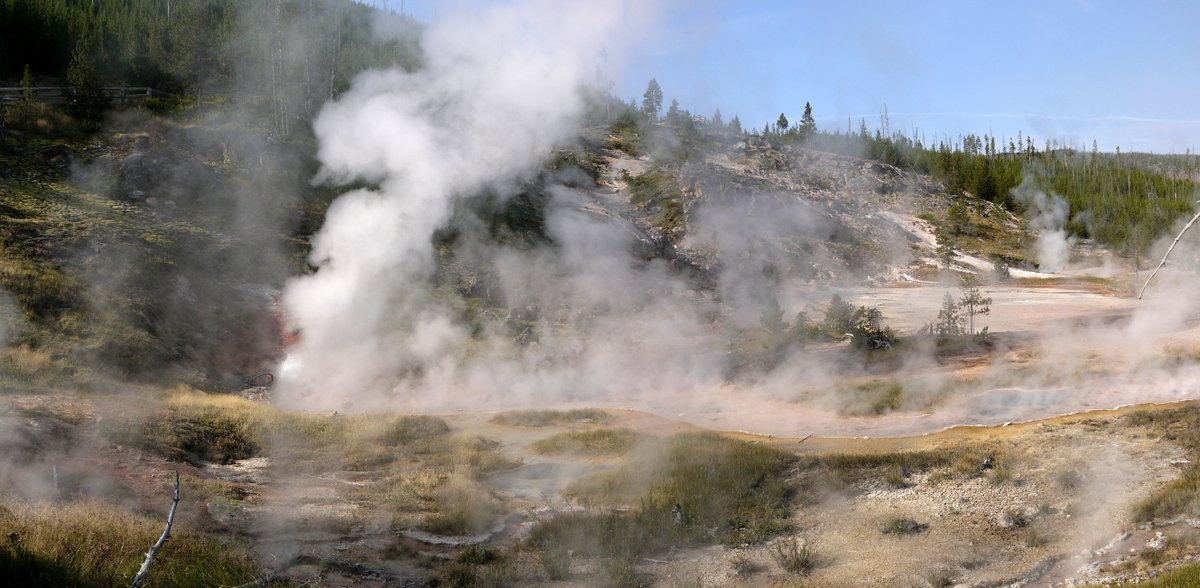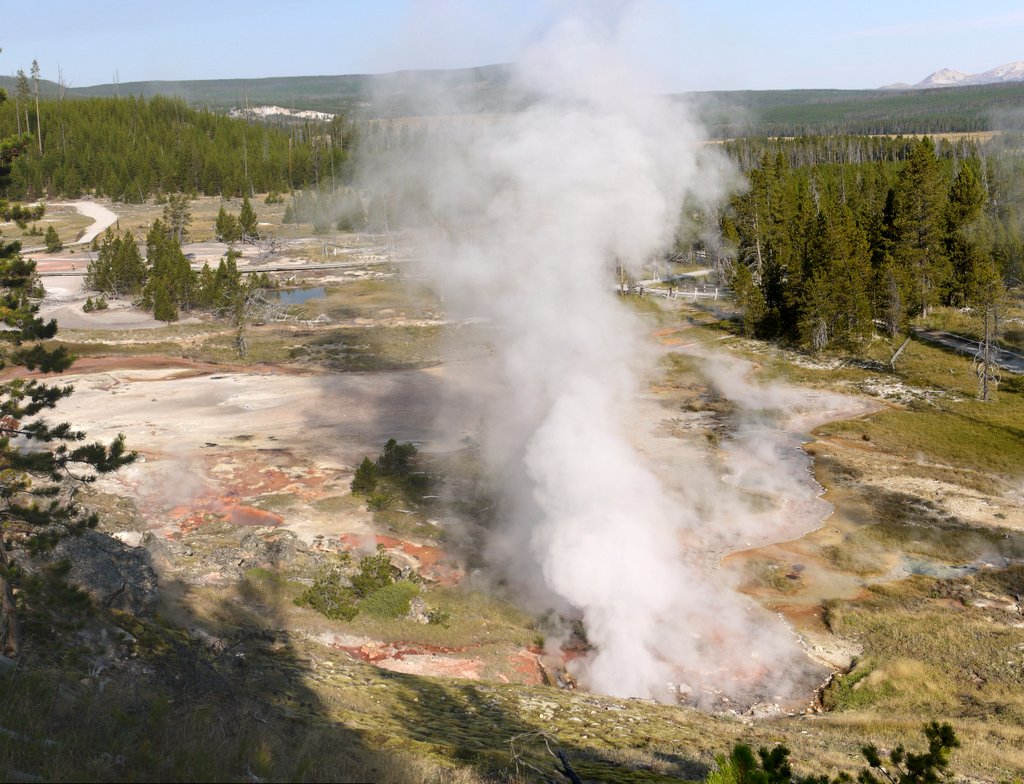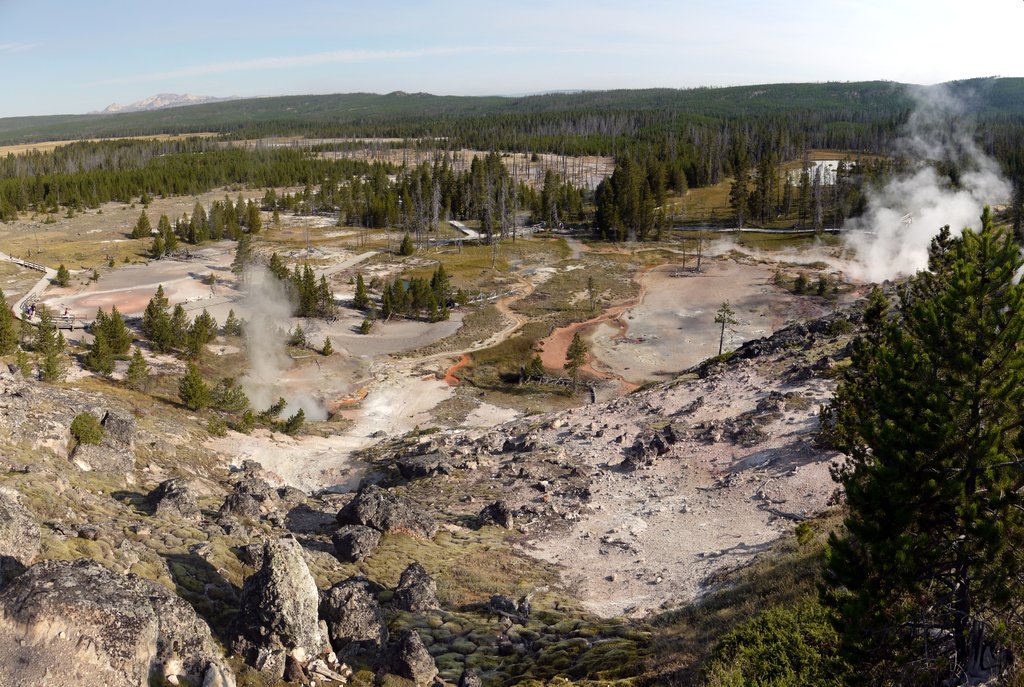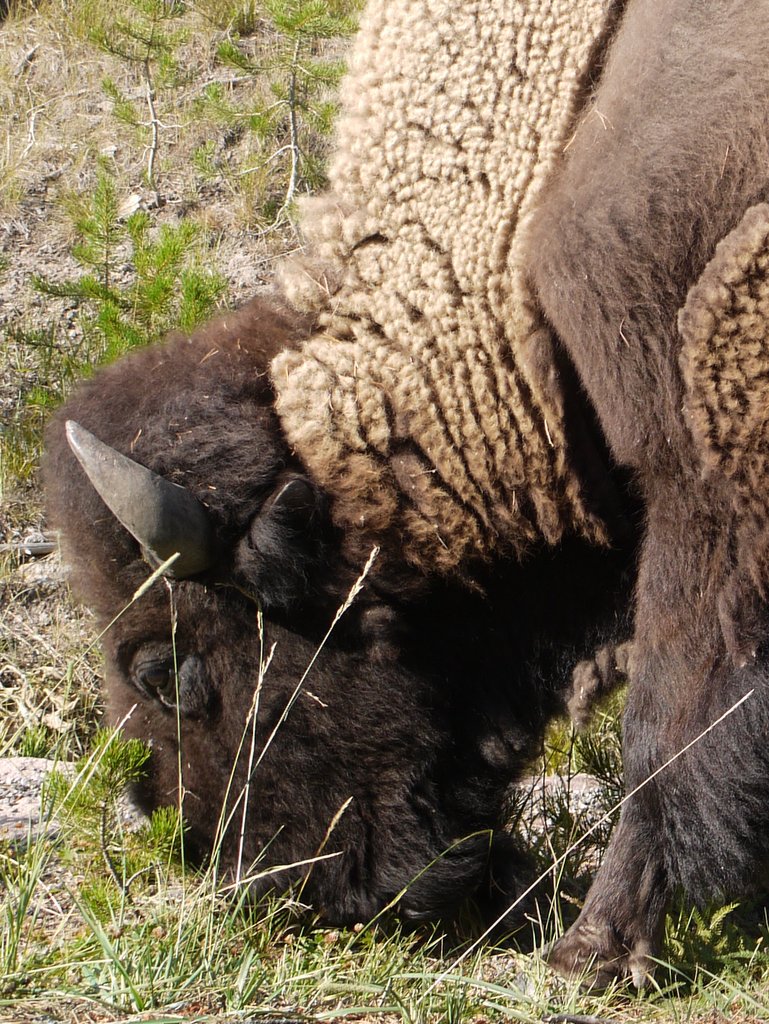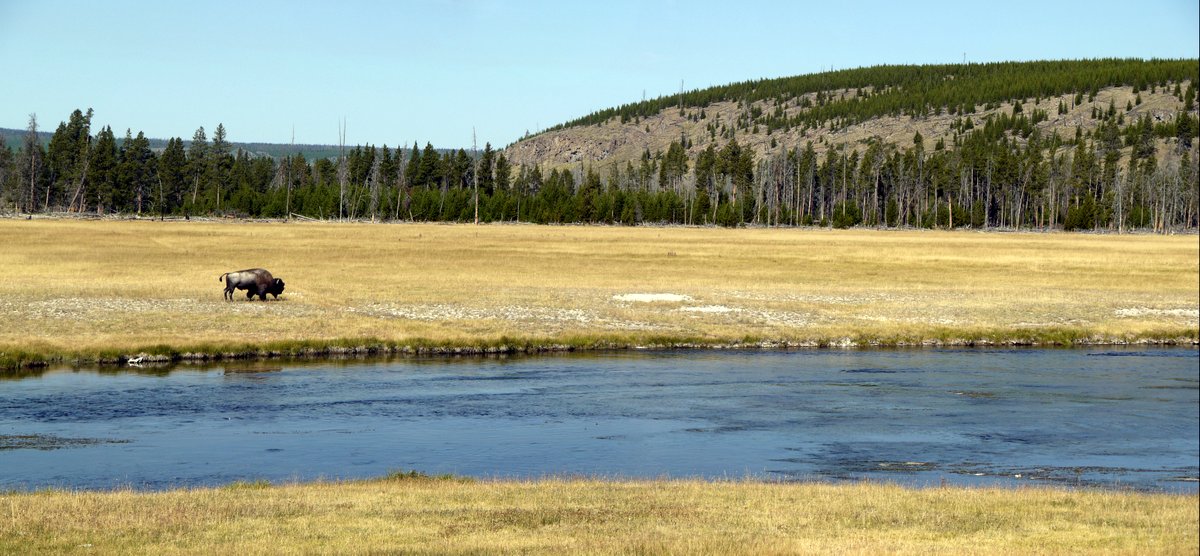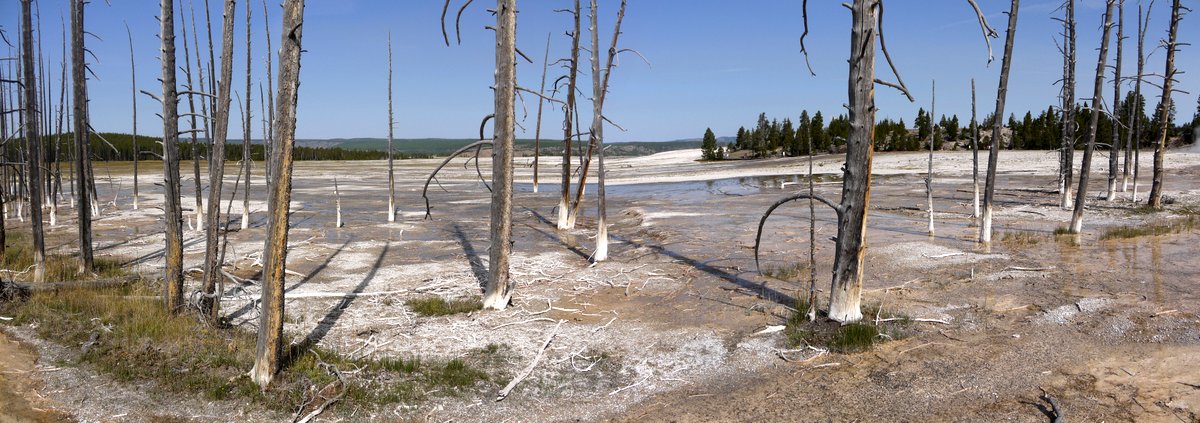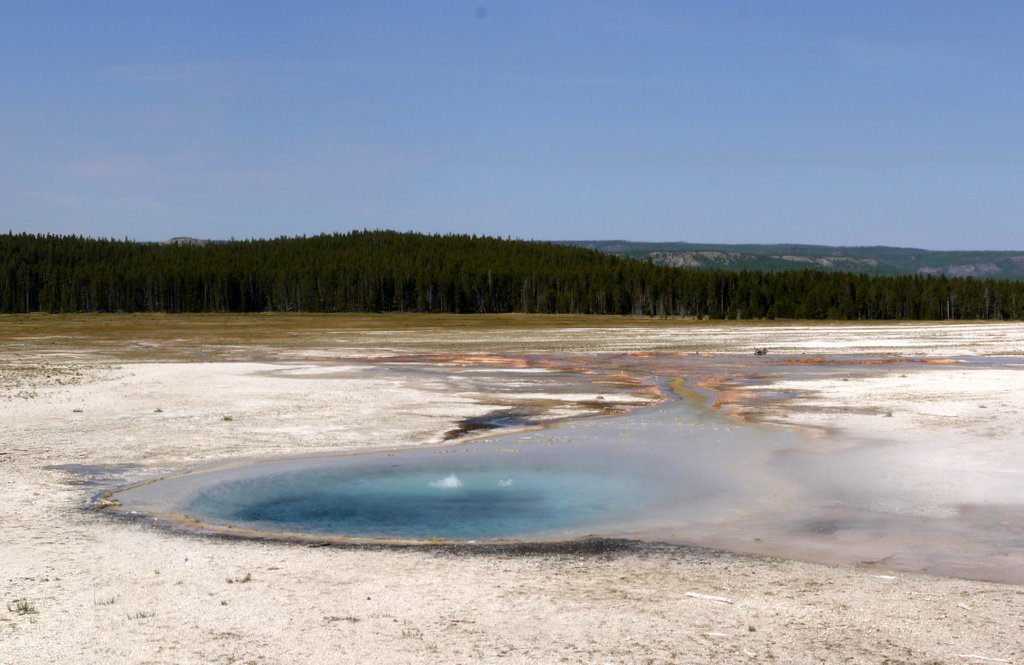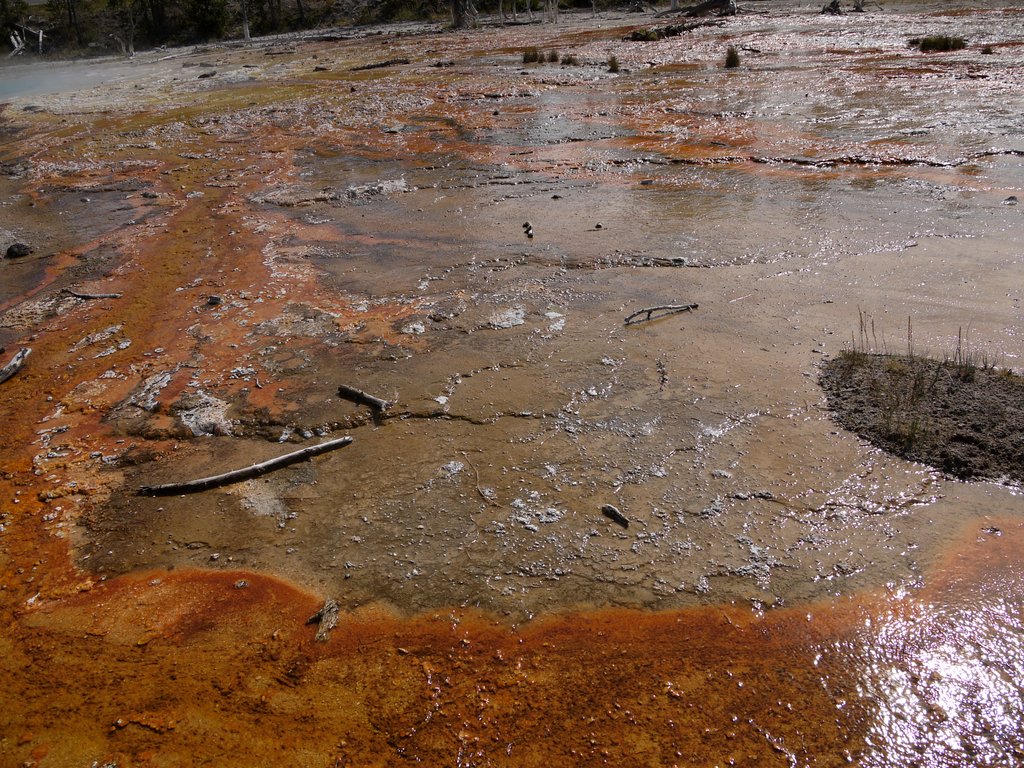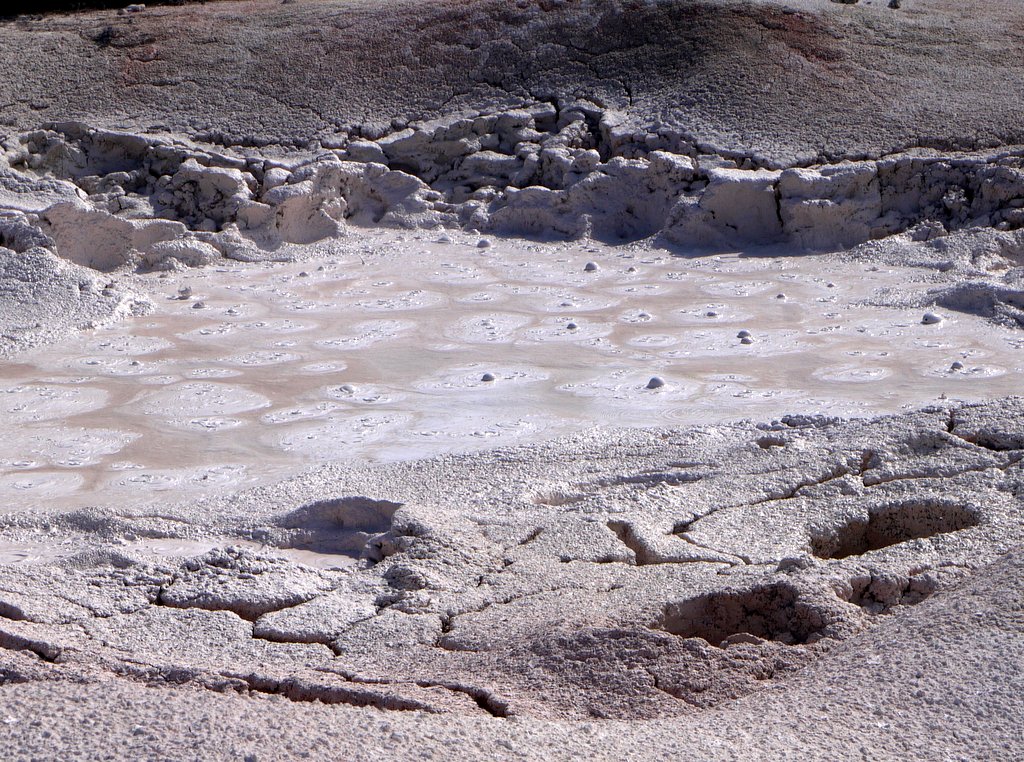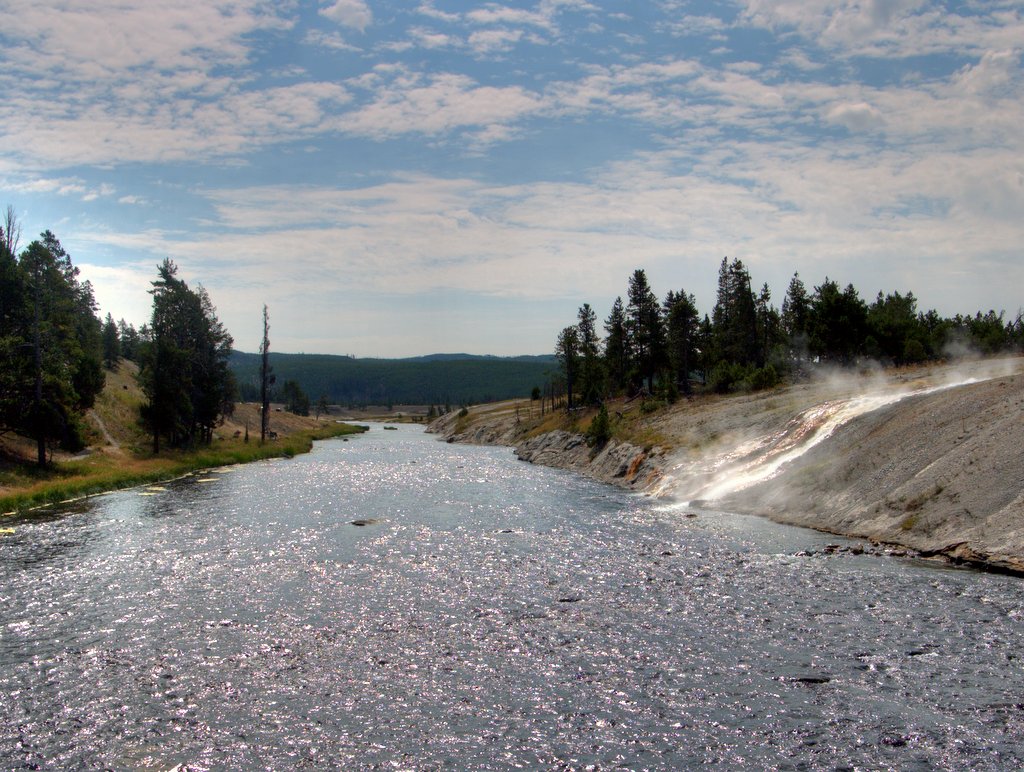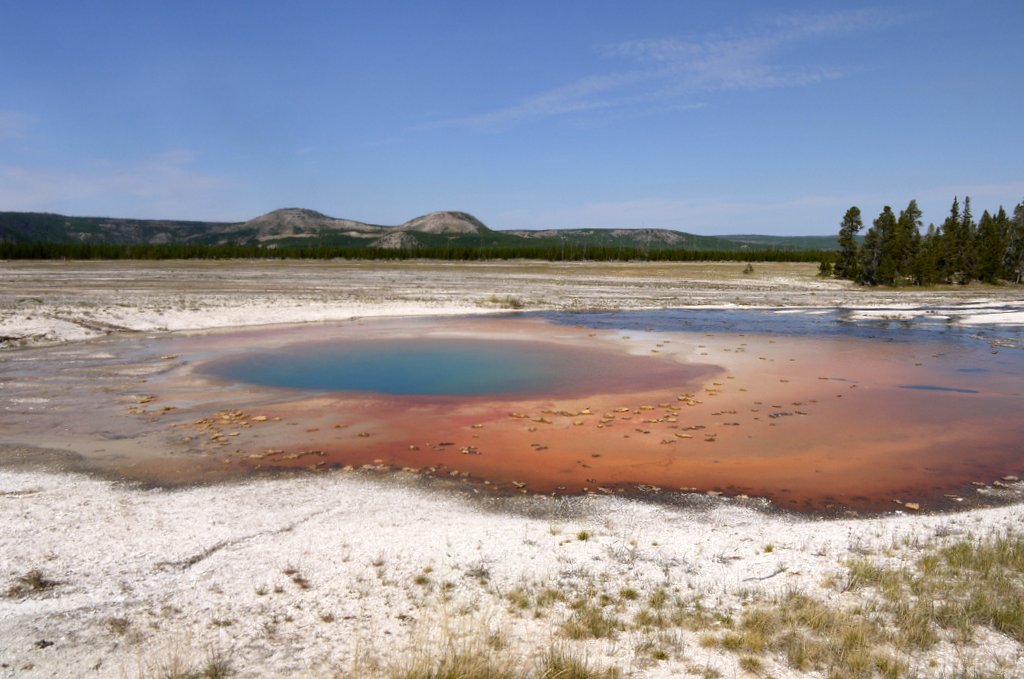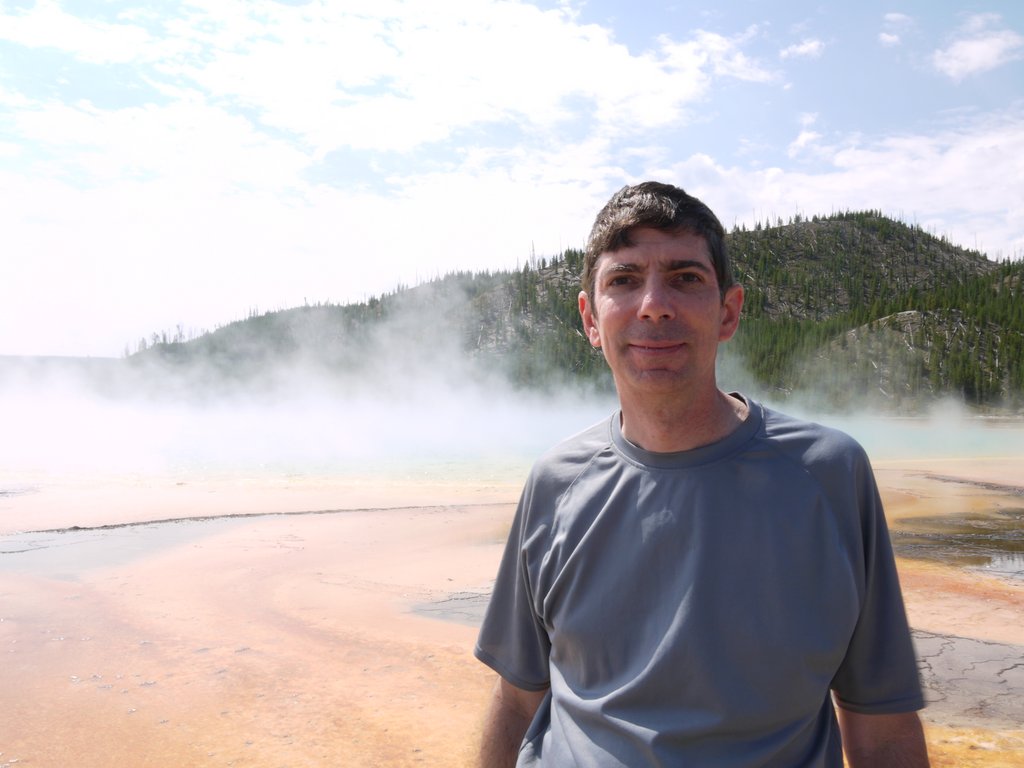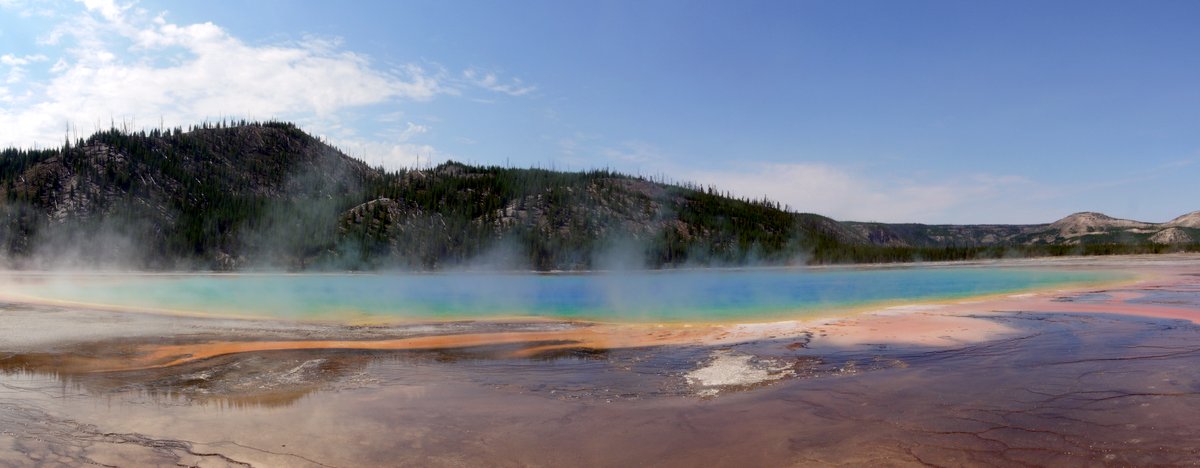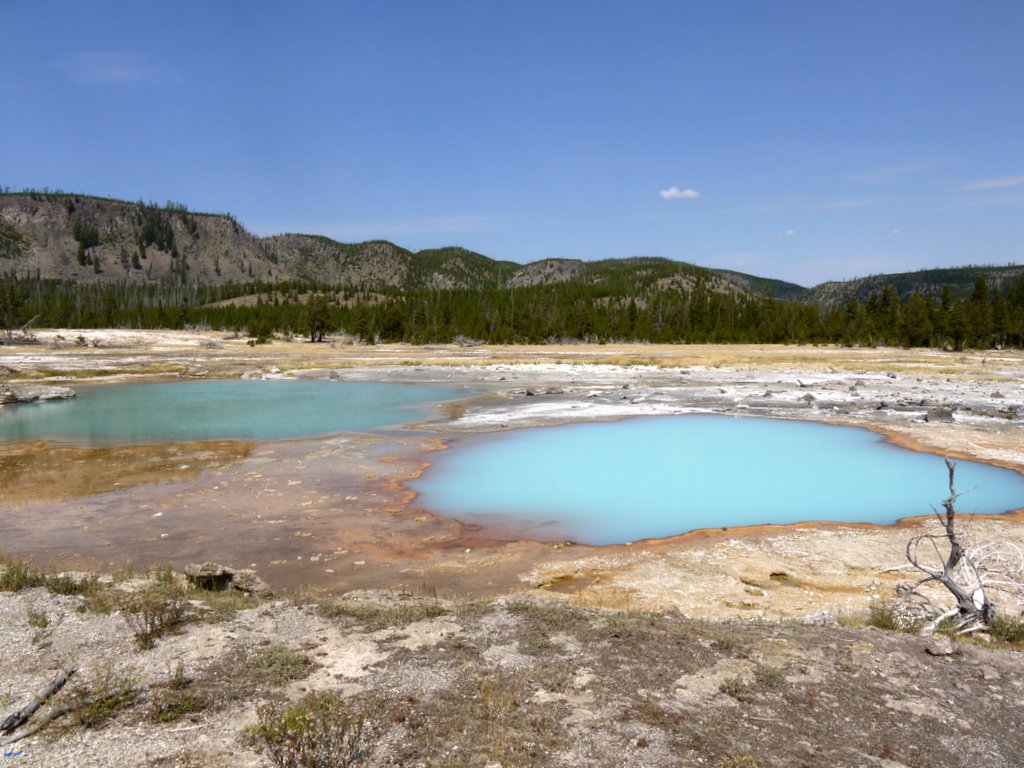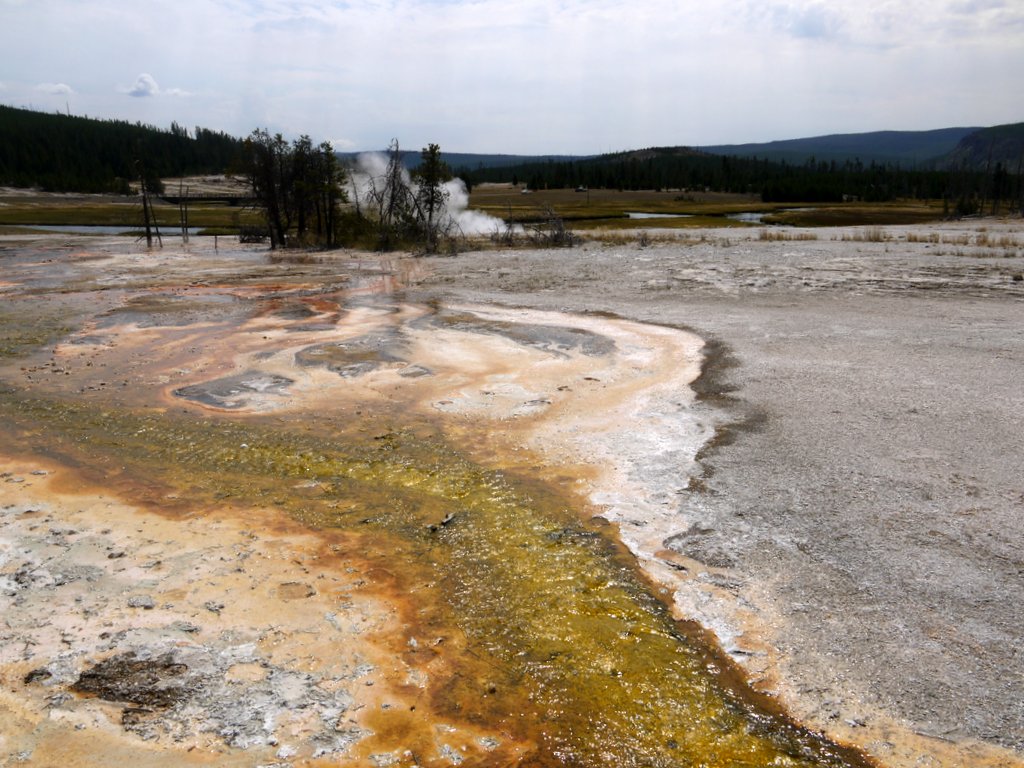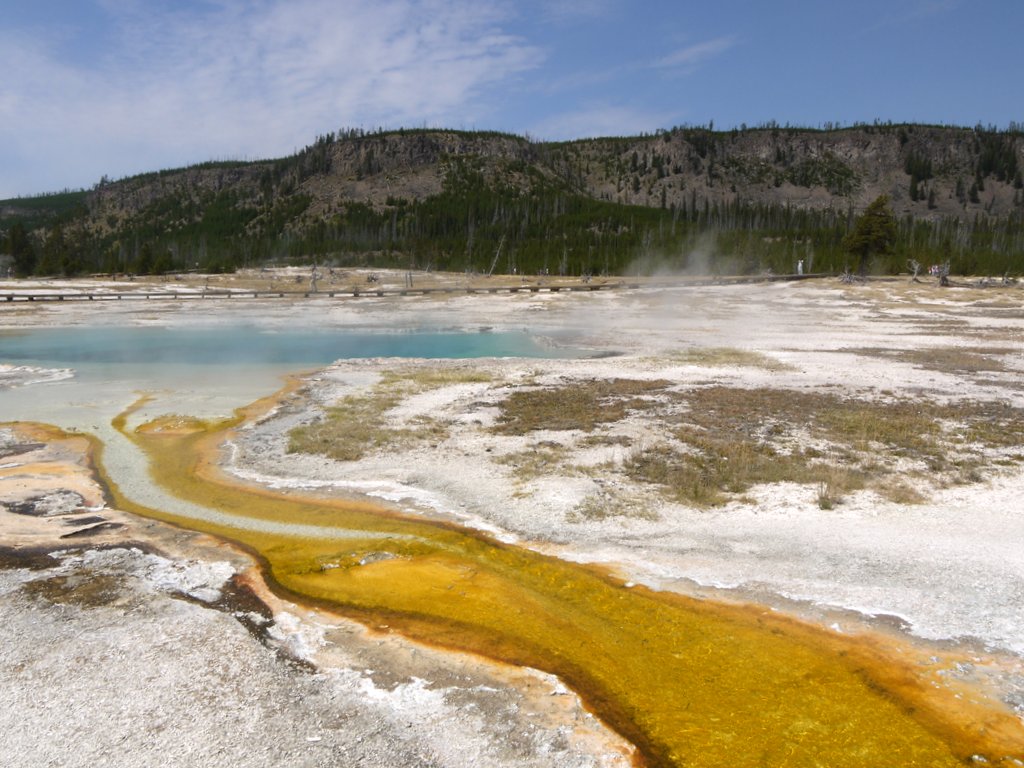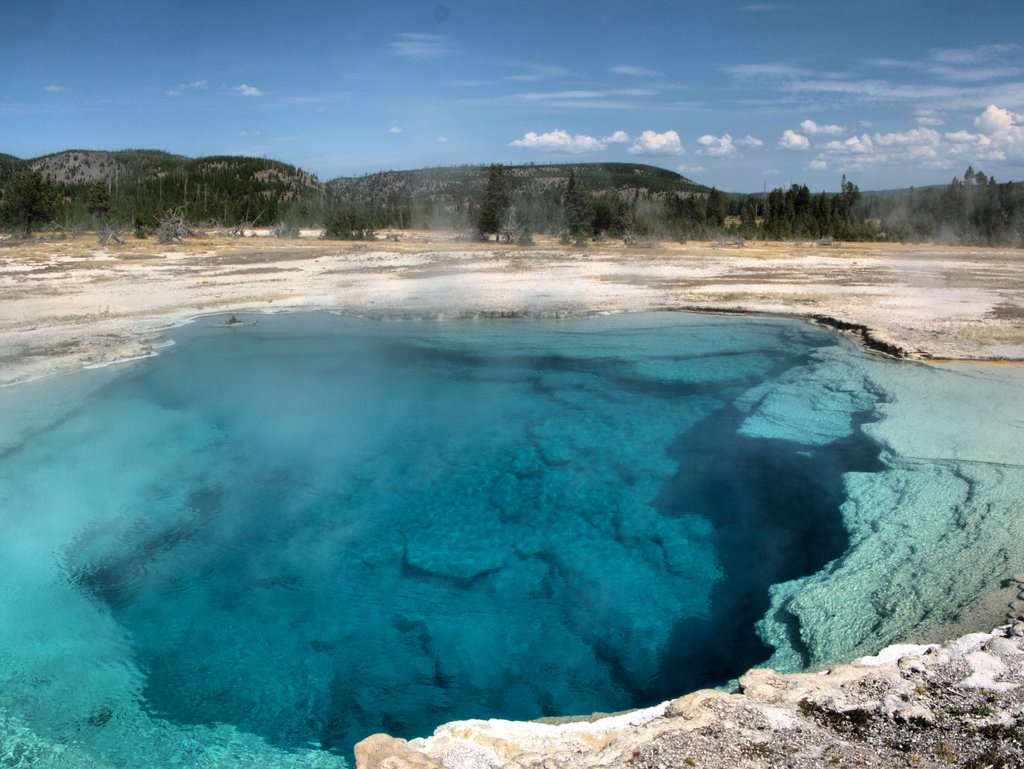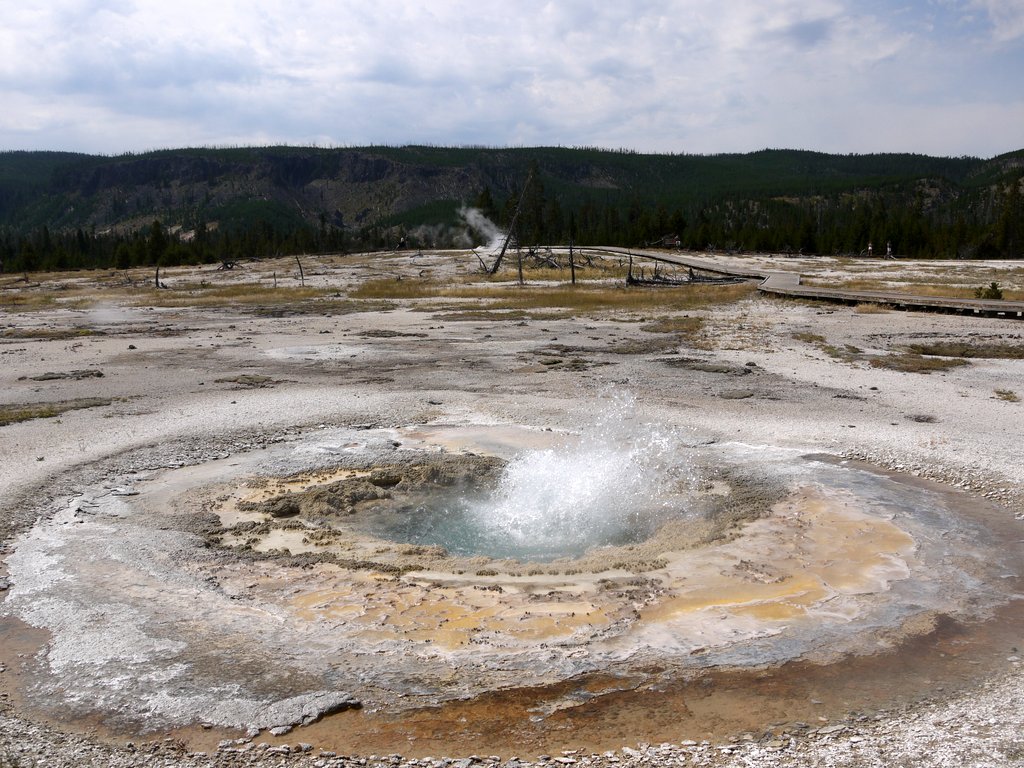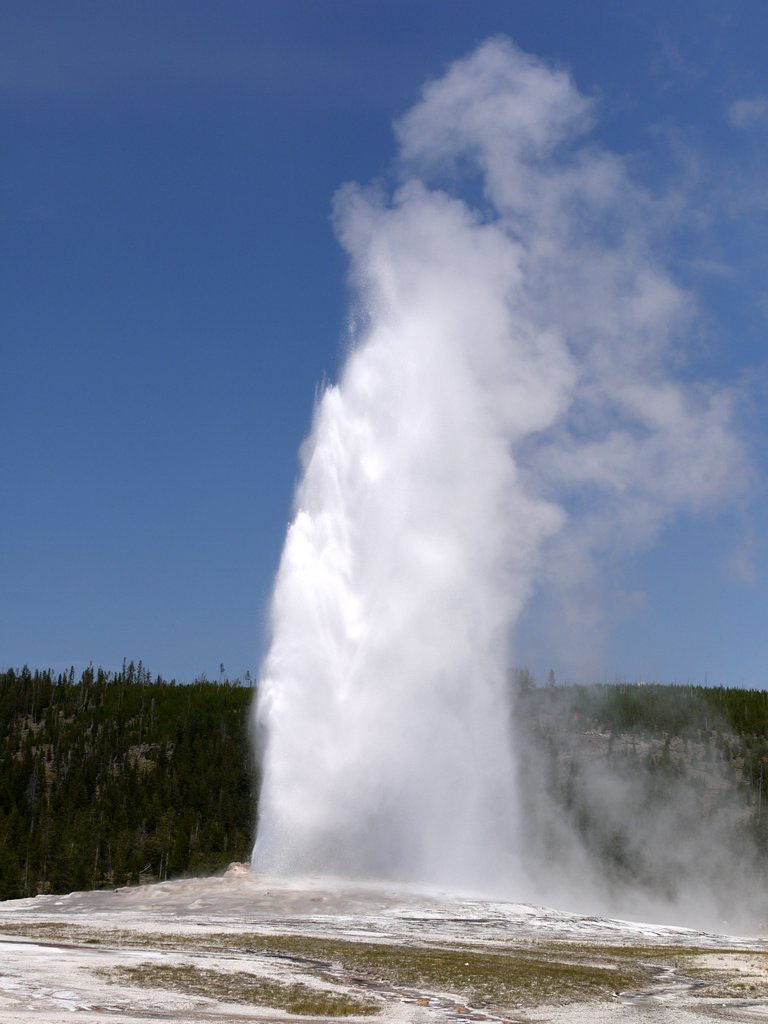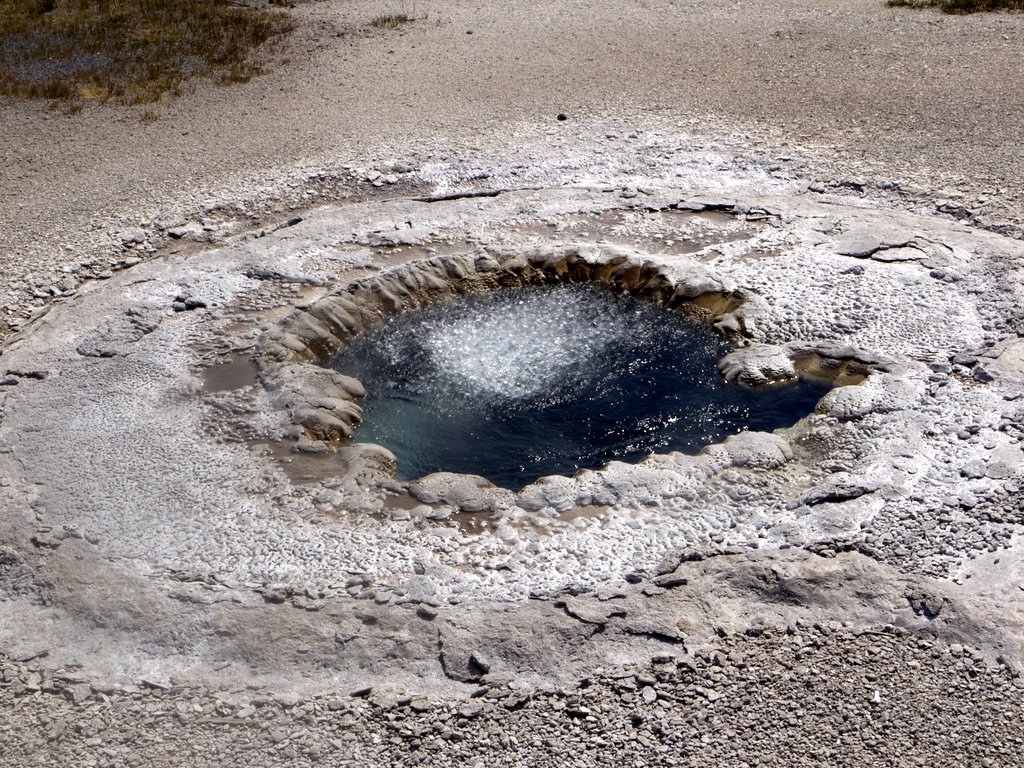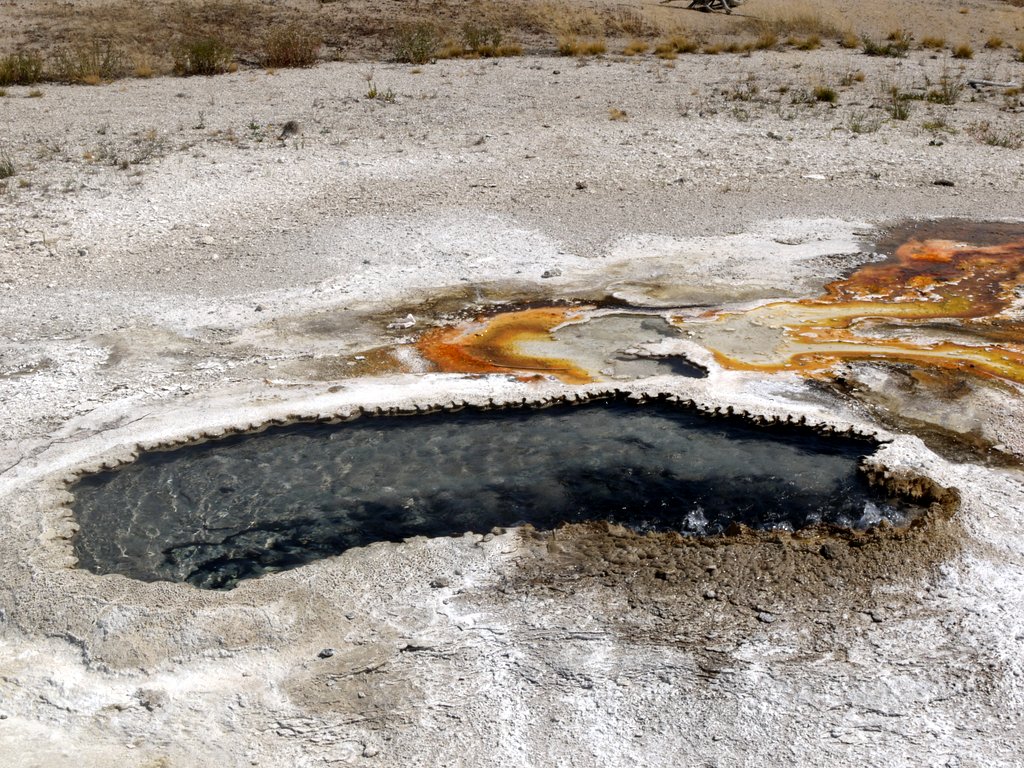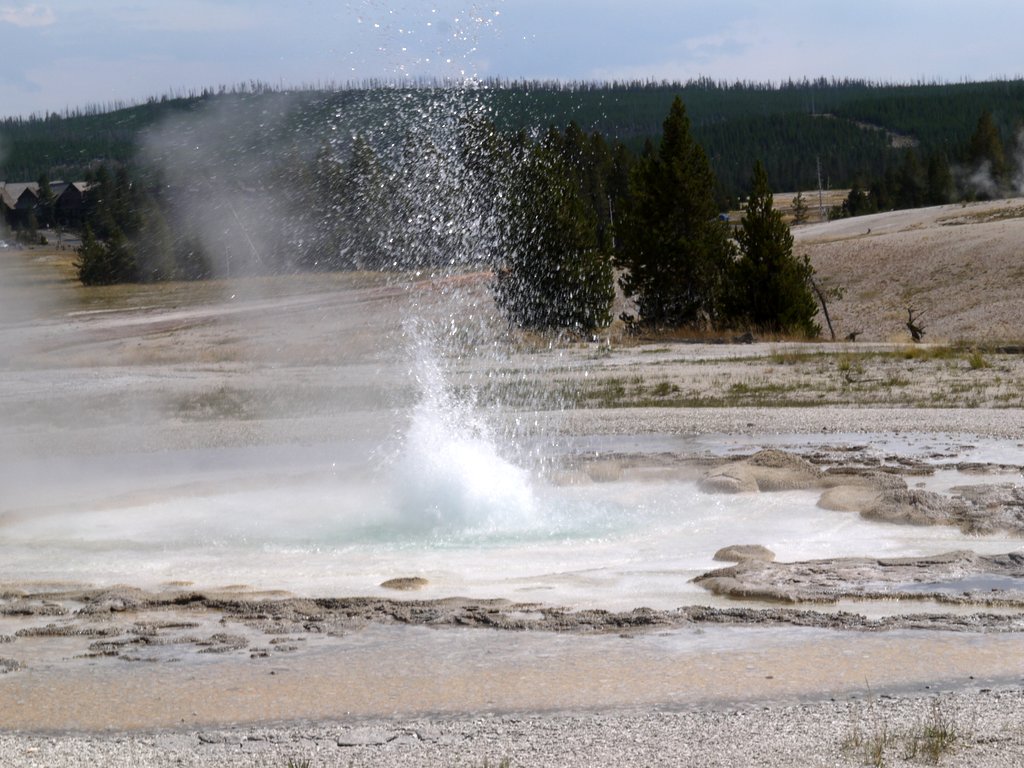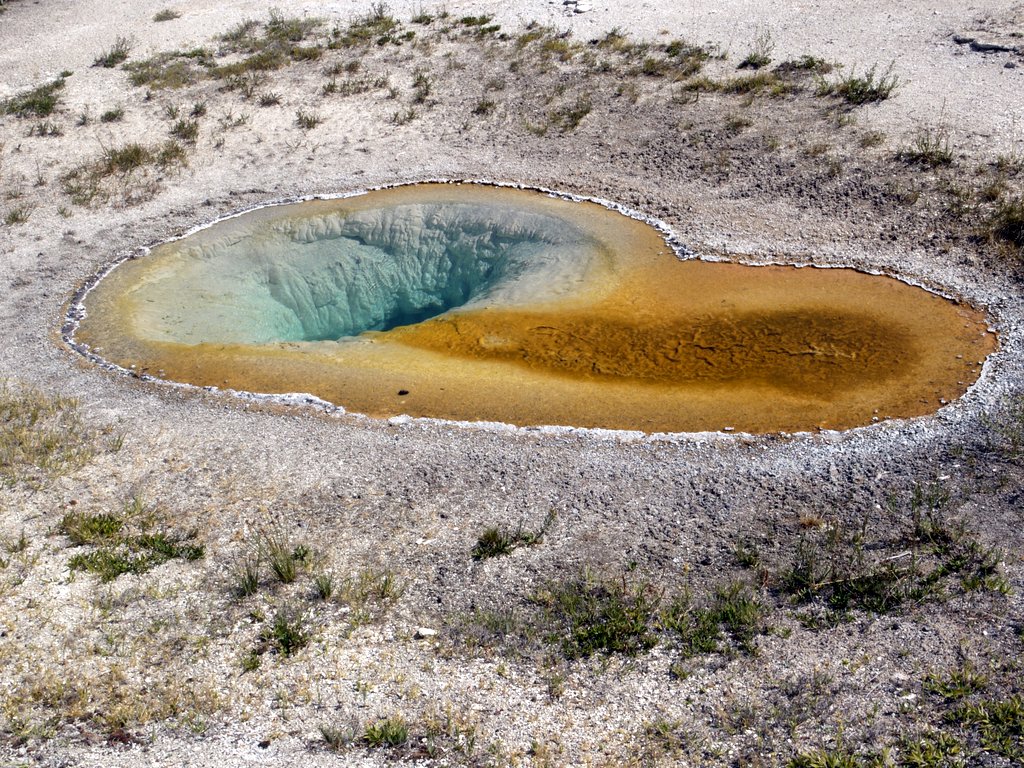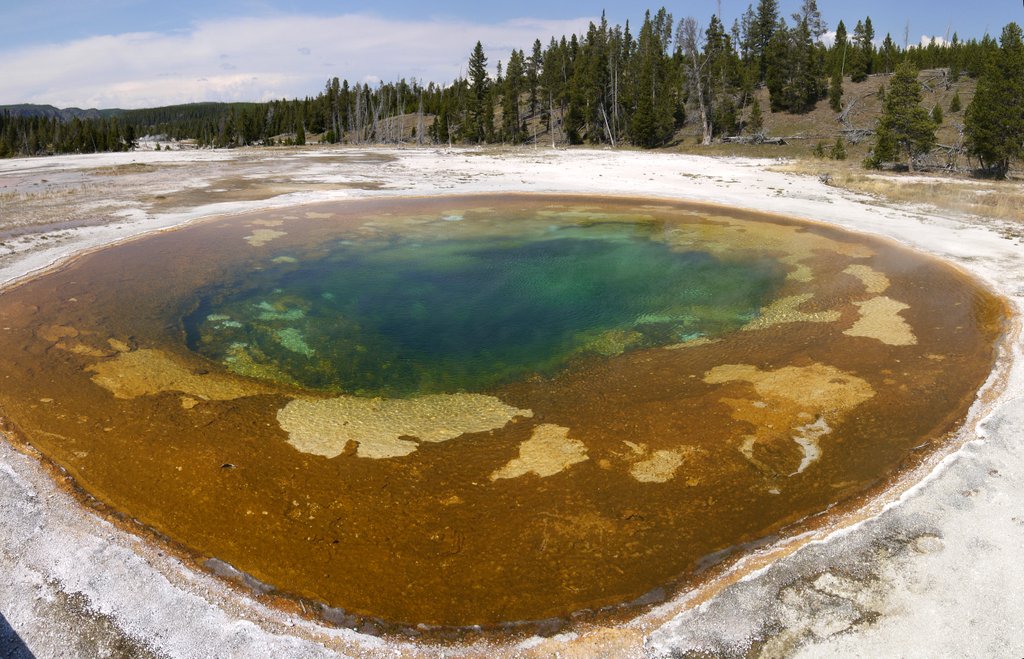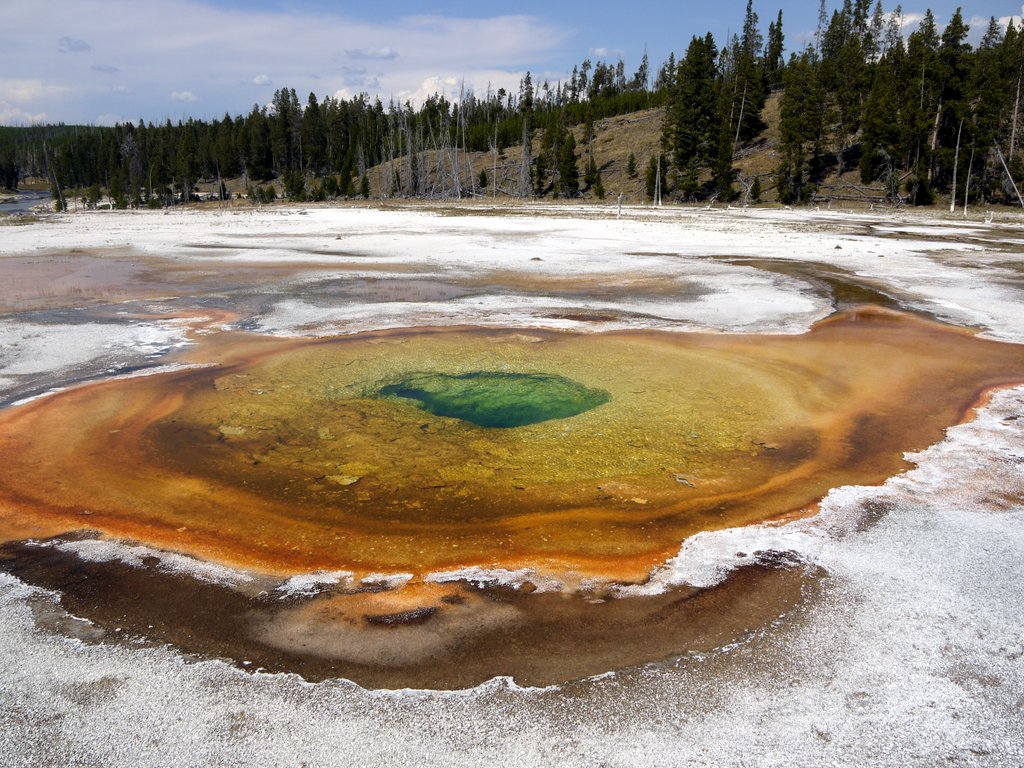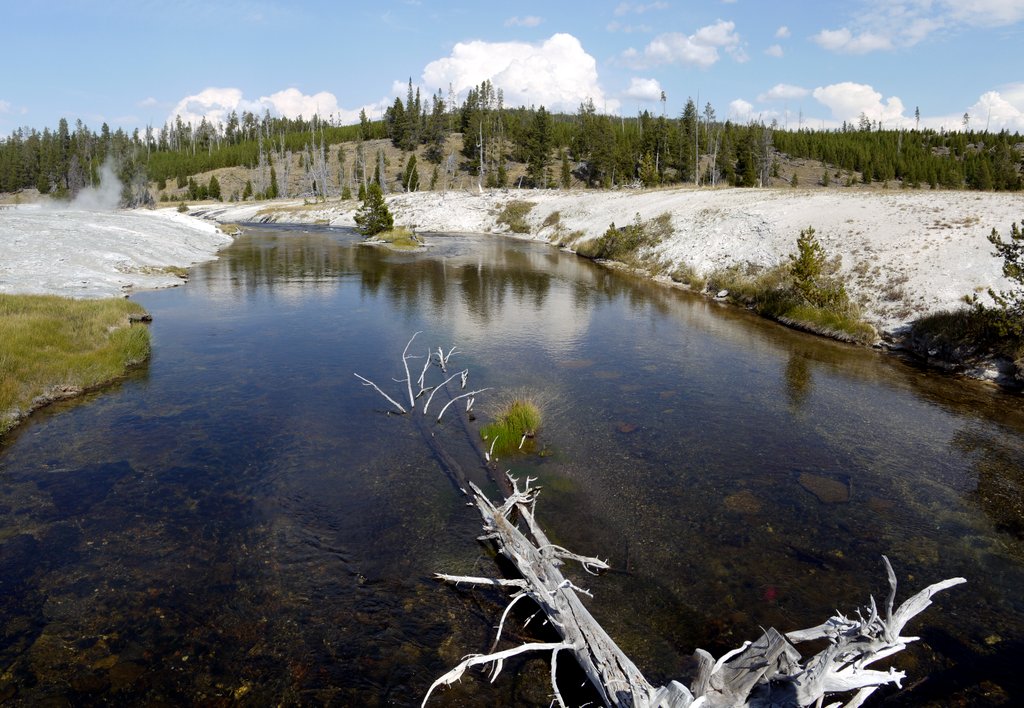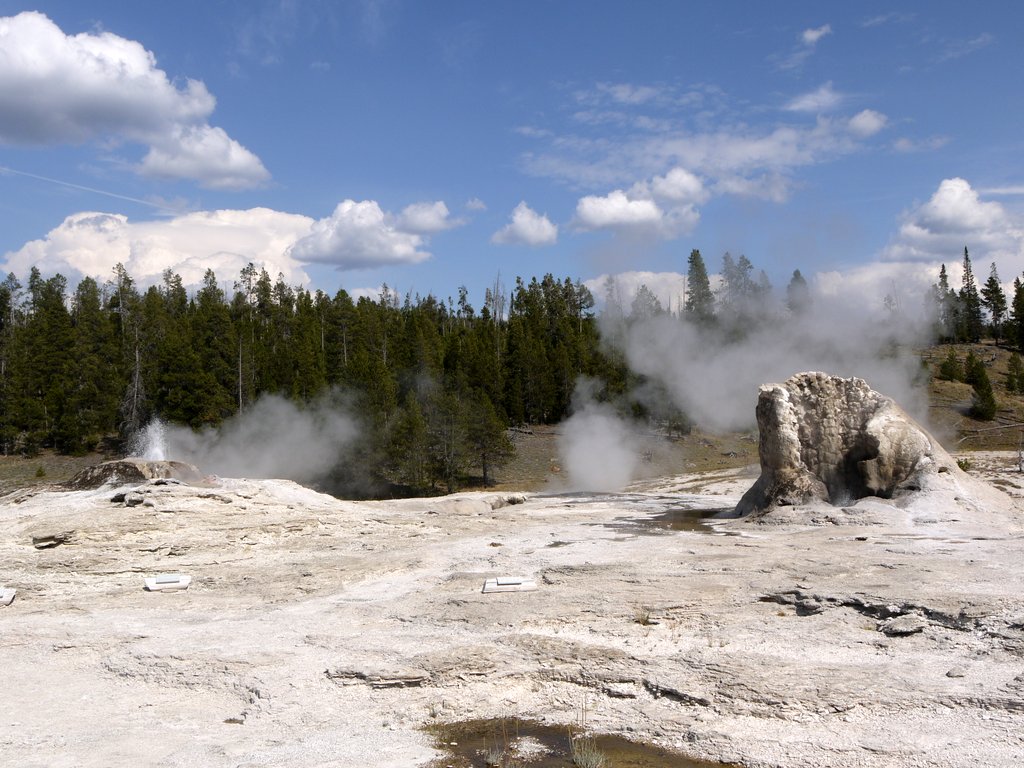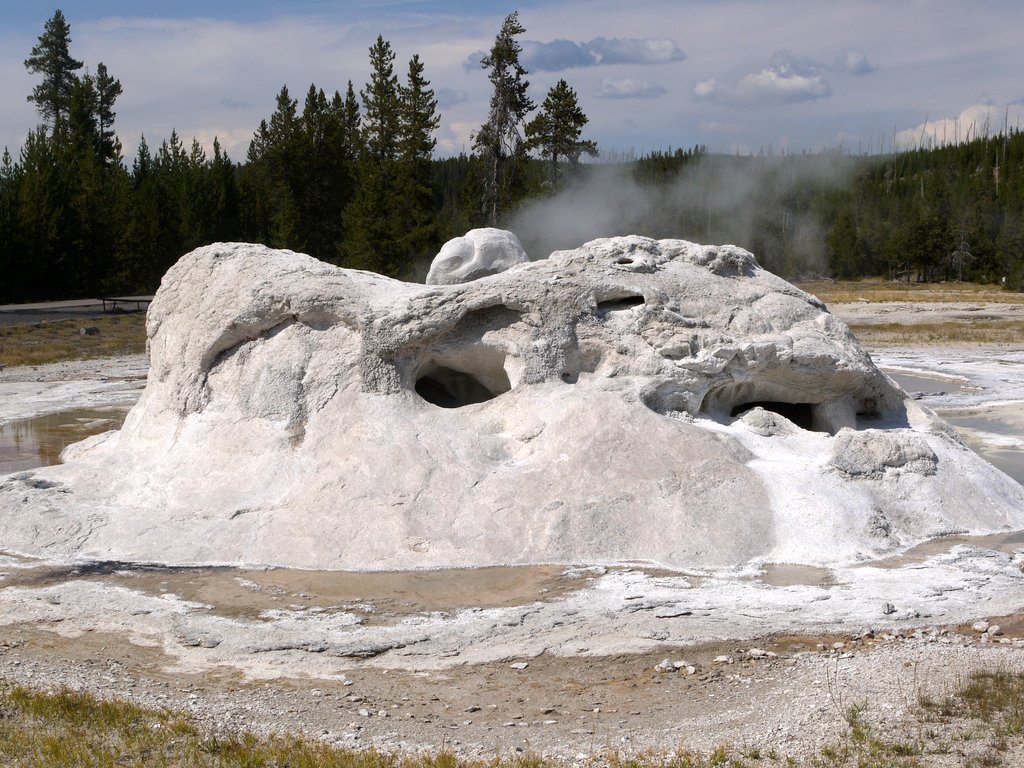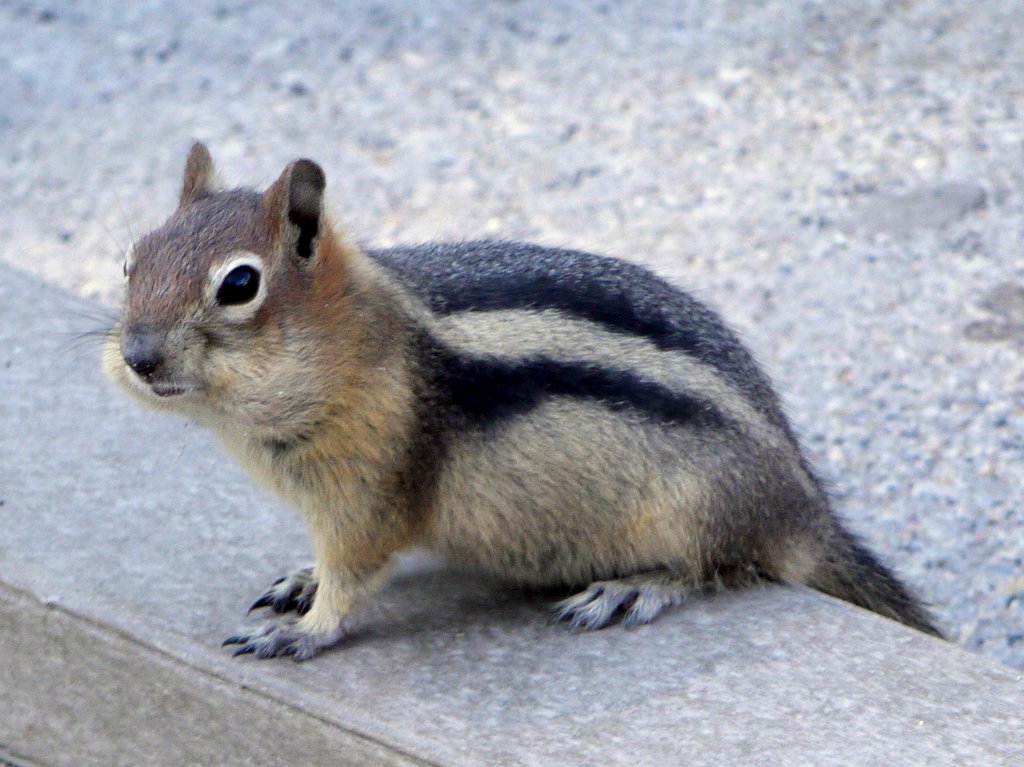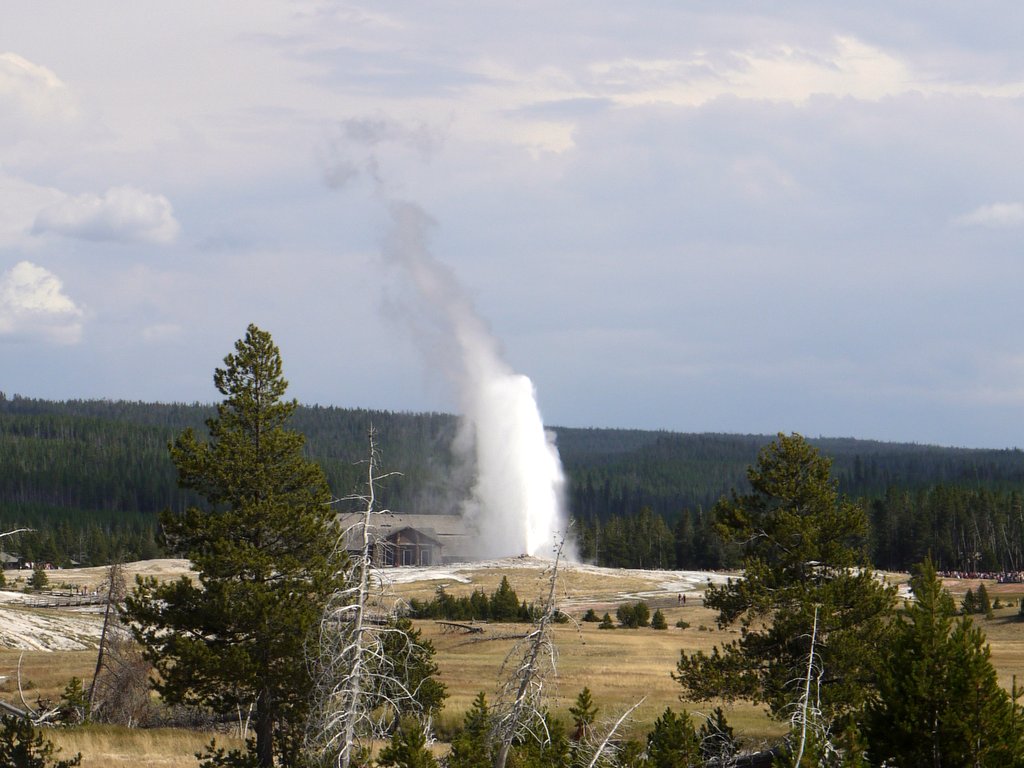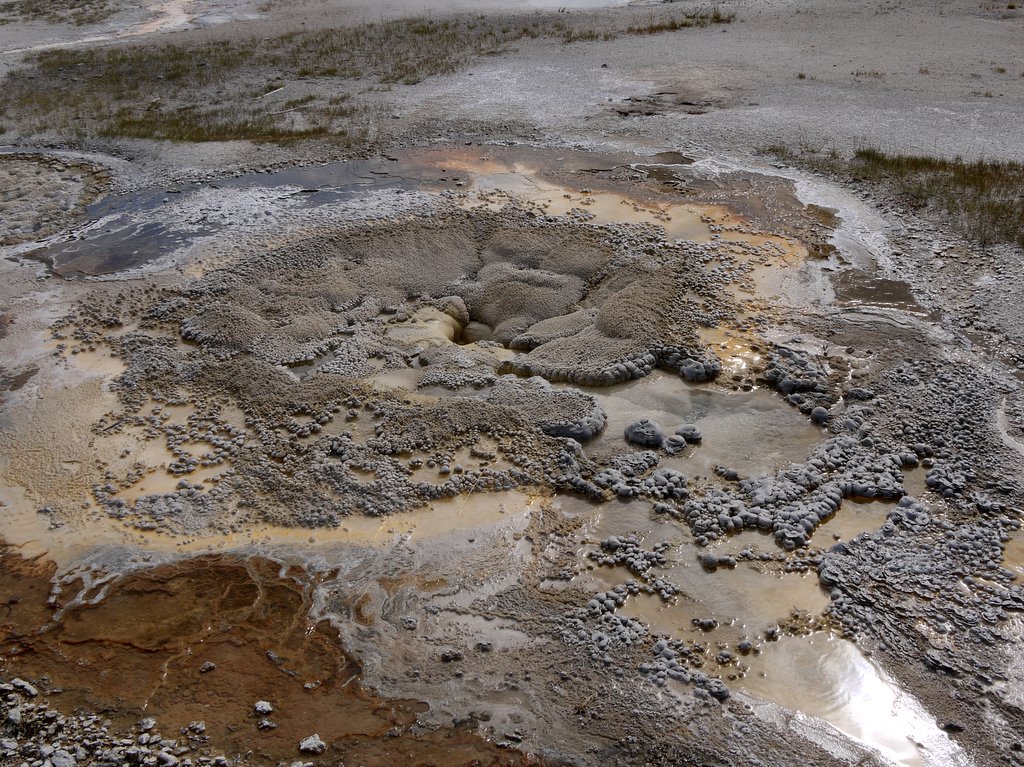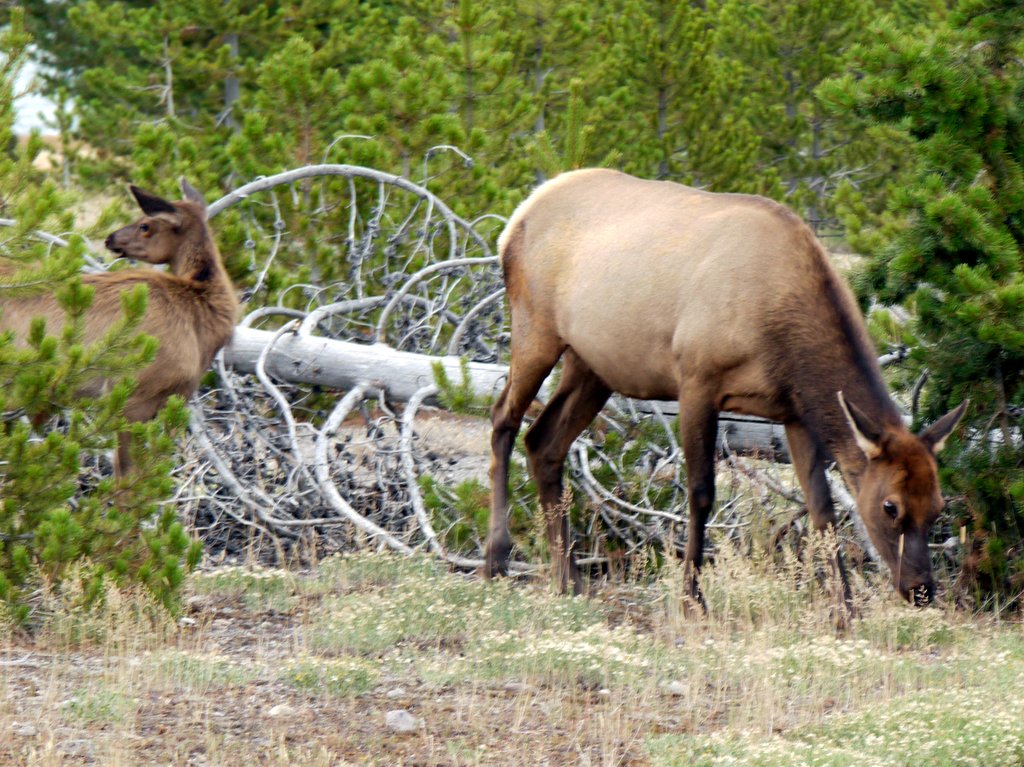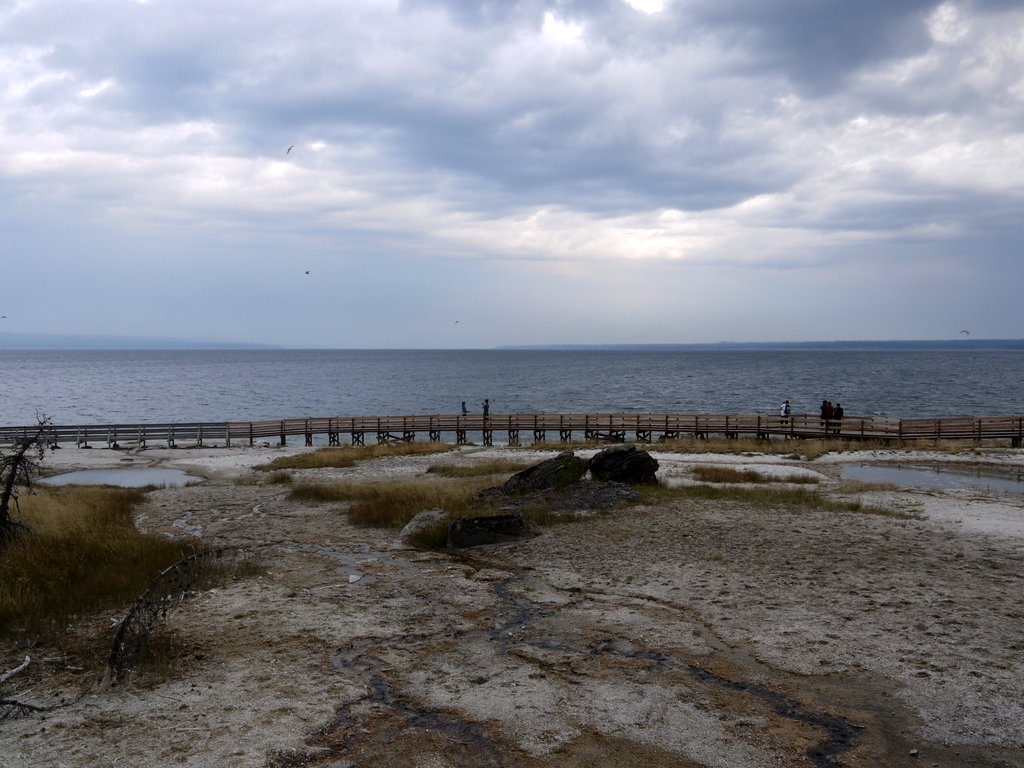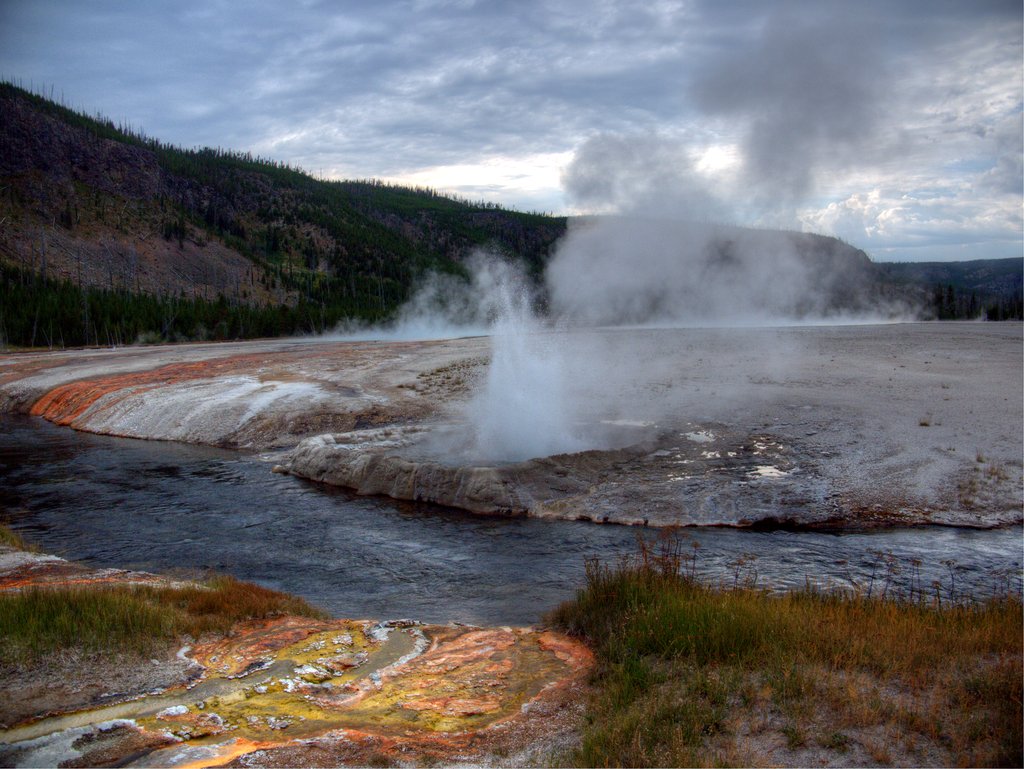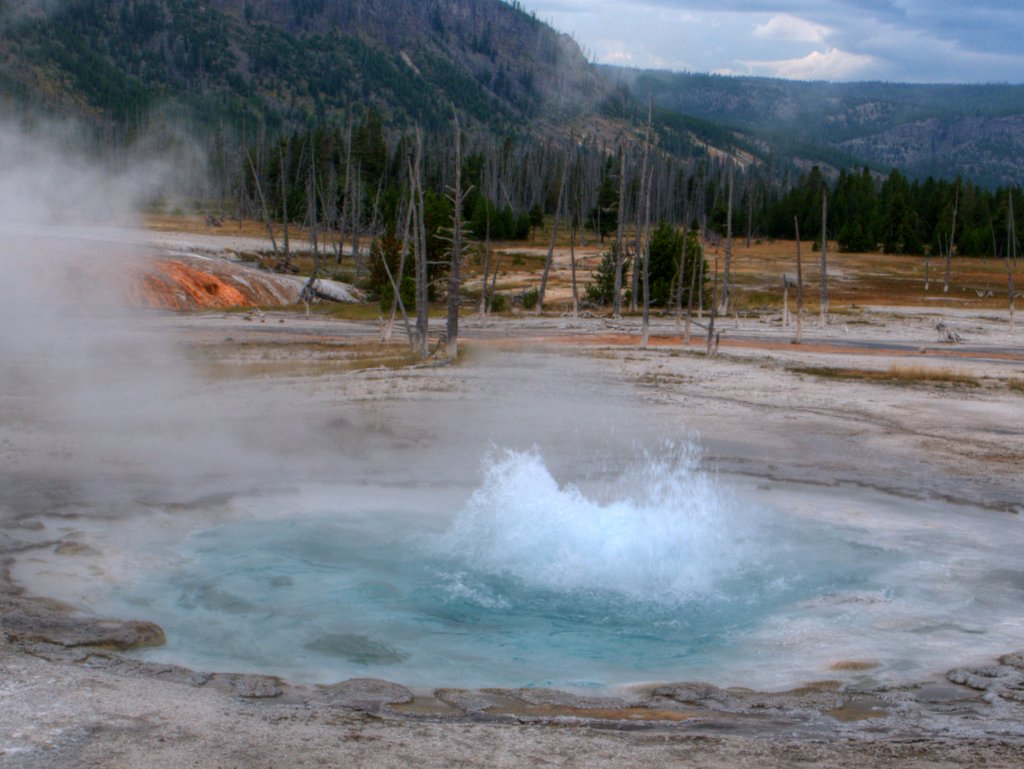Wednesday: As the fires south of Canyon blocked our direct path to Grand Teton, we postponed our hike there, hoping that we could go on Thursday. Instead, we decided to spend the day investigating the geyser basins in the Old Faithful area. We drove west from Canyon, then turned south at the Norris Junction, stopping first three miles south of the junction, at Artist Paintpots, within the Gibbon Geyser Basin.
9:23 a.m.: A 0.6 mile loop trail led through a series of springs, geysers, fumaroles, and mud pots. The fumaroles were generating a fair amount of water vapor:
The trail included a hill which provided a nice elevated view of the small basin:
Another elevated view of the basin:
This photo provides a good illustration that thermal features may be hidden under a few inches of a thin crust. Therefore, it is imperative to remain on the trail when visiting geothermal features of Yellowstone.
Continuing south, we passed a bison by the side of the road. Many of the bison have retained patches of their winter coats, apparently not caring if they are fashionable or not.
A detail of the bison’s head:
Another bison, grazing alone in a field framed by a river, mountains and sky:
At the Madison Junction, we continued south, arriving at the Fountain Paint Pot area, within the Lower Geyser Basin.
10:42 a.m.: Overflowing hot springs have killed a stand of trees, and minerals from the water have given the dead trees a “bobby socks” effect:
This is Celestine Pool:
While the hot waters kill off trees and vegetation, some bacteria do grow and thrive in the hot water:
Bubbles rise to the surface of a mud pot:
The Clepsydra Geyser erupts nearly constantly, spitting out 675 gallons per minute, to a height of 10-40′. It was named for an ancient Greek water clock:
Leaving the Fountain Paint Pot area, we took a detour from the Grand Loop Road to drive north on the one-way Firehole Lake Drive. However, the Great Fountain Geyser was not showing any sign of life during our brief stop there, and I did not record any memorable photos on the Drive. Returning to the Grand Loop Road, we again turned south.
11:56 a.m.: Our next stop was Midway Geyser Basin, where a pedestrian bridge led us across the Firehole River. Runoff from a hot spring poured into the river:
This is Turquoise Pool, about 100′ in diameter, with a temperature of 142-160 degrees Fahrenheit.
This is Opal Pool:
I’m posing in front of Grand Prismatic Spring, which looks prettier from the hill behind me. We’ll climb up there on Friday for a better look.
A ground-level panorama of Grand Prismatic Spring:
12:46 p.m.: Returning to the car and continuing south, our next stop was Biscuit Basin, an isolated thermal group that is part of the Upper Geyser Basin. These are Black Diamond and Opal Pools:
The runoff seen in the next two photos is low enough in temperature to allow mustard-colored bacteria or algae to flourish:
Sapphire Pool is about 18′ x 30′, with temperatures of 200 degrees Fahrenheit:
Jewel Geyser erupts for about a minute every 5-10 minutes, reaching a height of 10-30′:
2:11 p.m.: We returned to the Upper Geyser Basin, which we had briefly visited the previous day to see Old Faithful. She was still putting on a good show:
We explored more of the Upper Geyser Basin. This is Beach Spring
Ear Spring, which is 4′ x 6′, is said to be shaped like a human ear.
Sawmill Geyser was showing signs of life:
Beauty Pool, 60′ in diameter, has a depth of 25′, with a temperature of 164 to 175 degrees Fahrenheit, which is cool enough to allow bacteria and algae growth:
Chromatic Pool:
A pedestrian bridge led across Firehole River:
There were many benches facing Giant Geyser, with people waiting for the next eruption. We joined them for about 1/2 hour, but eventually grew bored and left. The geyser can reach a height of 150-250′, so it would certainly have been nice to see it erupt. The reality is that Old Faithful is probably the only large geyser that erupts with any regularity, so one must be lucky to see other large geysers, or have a lot of patience, or else settle for Old Faithful and a number of the small geysers.
Grotto Geyser has an unusual formation that is nearly 8′ high.
A cute chipmunk was kind enough to pose for me, as the geysers were not cooperating:
3:47 p.m.: This time we saw Old Faithful from a distance, with Old Faithful Lodge behind it:
5:20 p.m.: We drove on to the West Thumb Geyser Basin, where we saw a number of elk, including this cow and calf:
A boardwalk ran along Yellowstone Lake, but the wind was kicking up and I decided against venturing down there.
We began retracing our path back to the campsite. On the drive south, we had temporarily skipped Black Sand Basin, another isolated group of the Upper Geyser Basin. We stopped there now.
6:05 p.m.: Cliff Geyser is situated right on the edge of Iron Creek. It can erupt up to 40′ high, and produce a tremendous amount of steam. We were lucky enough to see it in action, at least to a certain extent:
Emerald Pool is 27′ x 38′, with a depth of 25′. Lower temperatures (154 degree Fahrenheit) have allowed yellow bacteria and algae to grow on the lining of the pool:
Spouter Geyser erupts almost constantly, with jets shooting to a height of 5-7′.
We then returned to the campsite. While we had not encountered any rain during the day, as we returned to the Canyon area it began to rain. The campsite was muddy in some areas, with the ground saturated enough to leave puddles standing in other areas. My tent was dry, though I had left my duffel bag in the vestibule of the tent formed by the rain fly. The vestibule does not have a floor to it, and water that had run under the vestibule had wet the bottom of my duffel bag. While the duffel bag is plastic coated on the inside, it is not waterproof, and I discovered that one shirt was very wet. Water had gotten into Julie’s tent, and the yoga mats that she used as a sleeping bag cushion were wet.
We went to the Camper Services building, where in addition to showers, we availed ourselves of the laundry facilities. I went through my duffel bag, finding a few other damp items, though nothing else soaked as that one shirt had been. I threw all the wet and damp clothes into a washer, together with the dirty clothes that I had accumulated. The building was also a nice dry place to hang out during the rainstorm.
Afterwards, we returned to the campsite. Julie felt that she could not sleep in her tent, owing to the damp condition, and she instead slept in the car. That would not have worked for my long legs, but she found it to be not terribly uncomfortable. I was happy that my new tent was dry. As for the problem with the floorless vestibule, I used a plastic bag and sandals to elevate my bag off the ground. When we went out during the day, I moved the duffel bag into the tent, so that it would be dry even if it rained heavily.
One good piece of news that we learned upon visiting the Camper Services building was that the road south of Canyon had re-opened, so that we would be able to have a direct drive to Grand Teton in the morning!
Coming up: Thursday we hike 14 miles in Grand Teton National Park.

